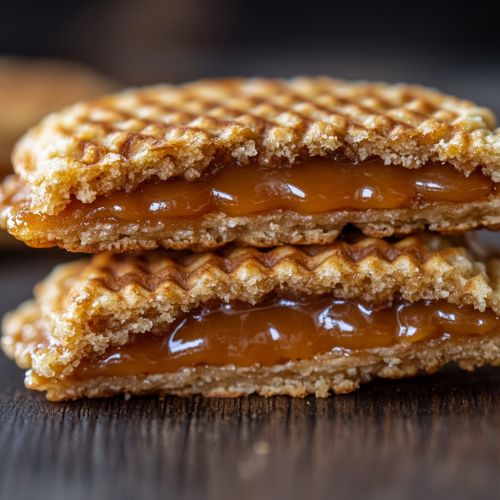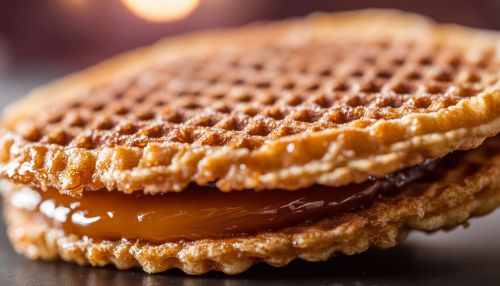Stroopwafel: Difference between revisions
(Created page with "== Introduction == The Stroopwafel is a traditional Dutch delicacy that has become an iconic representation of the Netherlands' rich culinary heritage. Known for its unique texture and flavor, the stroopwafel consists of two thin, crisp waffles with a caramel-like syrup filling. This confectionery item is not only a popular treat in the Netherlands but has also gained international recognition. The stroopwafel's history, production methods, and cultural significance...") |
No edit summary |
||
| Line 15: | Line 15: | ||
The production of stroopwafels involves several precise steps to achieve the desired texture and flavor. After preparing the dough, it is divided into small portions and pressed in a waffle iron. The waffles are then sliced horizontally while still warm to create two thin layers. The syrup is spread evenly between the layers before they are pressed together. This process requires skill to ensure the waffles are thin and crispy, while the syrup remains gooey and flavorful. | The production of stroopwafels involves several precise steps to achieve the desired texture and flavor. After preparing the dough, it is divided into small portions and pressed in a waffle iron. The waffles are then sliced horizontally while still warm to create two thin layers. The syrup is spread evenly between the layers before they are pressed together. This process requires skill to ensure the waffles are thin and crispy, while the syrup remains gooey and flavorful. | ||
[[Image:Detail-98393.jpg|thumb|center|Close-up of a freshly made stroopwafel with visible caramel syrup filling.|class=only_on_mobile]] | |||
[[Image:Detail-98394.jpg|thumb|center|Close-up of a freshly made stroopwafel with visible caramel syrup filling.|class=only_on_desktop]] | |||
== Variations and Innovations == | == Variations and Innovations == | ||
Latest revision as of 10:46, 11 October 2024
Introduction
The Stroopwafel is a traditional Dutch delicacy that has become an iconic representation of the Netherlands' rich culinary heritage. Known for its unique texture and flavor, the stroopwafel consists of two thin, crisp waffles with a caramel-like syrup filling. This confectionery item is not only a popular treat in the Netherlands but has also gained international recognition. The stroopwafel's history, production methods, and cultural significance offer a fascinating insight into Dutch gastronomy.
Historical Background
The origins of the stroopwafel can be traced back to the city of Gouda, Netherlands, in the late 18th or early 19th century. It is believed that the first stroopwafels were created by bakers using leftover crumbs and syrup, making it an economical treat. Over time, the recipe evolved, and the stroopwafel became a staple in Dutch households. By the 19th century, the stroopwafel had gained popularity beyond Gouda, becoming a beloved snack throughout the Netherlands.
Ingredients and Composition
The stroopwafel is composed of two main components: the waffle and the syrup filling. The waffle is made from a dough that typically includes flour, butter, sugar, yeast, milk, and eggs. The dough is rolled into balls and pressed in a specialized waffle iron to create thin, crisp waffles. The syrup filling, known as "stroop," is made from a mixture of brown sugar, butter, and cinnamon, which is heated until it reaches a thick, caramel-like consistency.
Production Process
The production of stroopwafels involves several precise steps to achieve the desired texture and flavor. After preparing the dough, it is divided into small portions and pressed in a waffle iron. The waffles are then sliced horizontally while still warm to create two thin layers. The syrup is spread evenly between the layers before they are pressed together. This process requires skill to ensure the waffles are thin and crispy, while the syrup remains gooey and flavorful.


Variations and Innovations
While the traditional stroopwafel remains the most popular, various innovations have emerged over the years. Some variations include the addition of spices such as cardamom or ginger, or the incorporation of different types of syrup, like honey or maple. Additionally, gluten-free and vegan versions have been developed to cater to dietary restrictions. These adaptations have helped the stroopwafel maintain its relevance in a modern culinary landscape.
Cultural Significance
The stroopwafel holds a special place in Dutch culture and is often associated with comfort and nostalgia. It is commonly enjoyed with coffee or tea, where the waffle is placed on top of the cup to allow the steam to soften the syrup. This practice enhances the flavor and texture of the stroopwafel, making it a cherished ritual for many. The stroopwafel is also a popular souvenir for tourists visiting the Netherlands, symbolizing the country's rich culinary traditions.
Global Popularity
In recent years, the stroopwafel has gained international popularity, with many countries embracing this Dutch treat. It is commonly found in supermarkets and specialty stores worldwide, and its unique flavor has inspired various culinary creations, including stroopwafel-flavored ice creams, desserts, and even liqueurs. The global appeal of the stroopwafel highlights its versatility and enduring charm.
Nutritional Information
While the stroopwafel is a delightful treat, it is important to consider its nutritional content. A typical stroopwafel contains carbohydrates, fats, and sugars, contributing to its caloric value. Moderation is advised, especially for individuals monitoring their sugar intake. However, the stroopwafel can be enjoyed as part of a balanced diet, offering a taste of Dutch culture in every bite.
